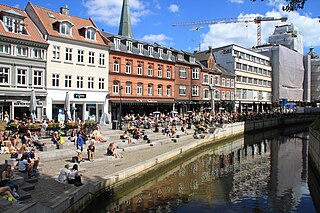Aarhus, Denmark’s second-largest city, is a vibrant and picturesque urban center that seamlessly blends rich historical charm with modern culture. From its origins as a fortified Viking settlement, Aarhus has evolved into a bustling hub of art, education, and innovation. Key attractions include the ARoS Art Museum, the Old Town Museum, and the bustling waterfront, which is replete with contemporary architecture and gastronomic delights. Whether it’s delving into history, exploring cutting-edge art, or enjoying the natural beauty, Aarhus offers a uniquely Scandinavian experience tailored for all ages.
When visiting Aarhus, be sure to explore the Latin Quarter, where the city’s oldest houses provide a charming backdrop for boutique shopping and fine dining.
Plan your visit around the Aarhus Festival, held annually in late summer, to experience the city’s vibrant cultural scene with music, art, and street performances.
Top things to do & see in Aarhus
Select the following sights and activities to discover best tickets and tours available in Aarhus.
Aarhus: The Heart of Jutland
| Country | Denmark |
| Time in Aarhus | GMT+1 |
| Language spoken | Danish |
| Population | 349,983 (Source: Statistics Denmark, 2023) |
| Currency | Danish Krone (DKK kr) |
| Airports |
|
Aarhus, often referred to as the “City of Smiles,” is Denmark’s second-largest city and a vibrant cultural hub. Nestled on the east coast of Jutland peninsula, Aarhus serves as an important port, a dynamic urban center with a rich history dating back to the Viking era. Today, Aarhus blends historical charm with modern innovation, hosting a variety of cultural institutions including the ARoS Aarhus Art Museum, one of the largest in Northern Europe, and The Old Town Museum, an open-air museum showcasing life from the 1700s to the 1970s in Denmark.
The city’s university, Aarhus University, is among the top 100 educational institutions worldwide, enriching the city with a youthful and international vibe. Annual events like Aarhus Festuge, the largest cultural festival in Scandinavia, and the jazz festival draw visitors from all over the globe. The revitalized waterfront area invites both locals and tourists to enjoy contemporary architecture and green spaces. Aarhus also acts as a culinary destination with numerous Michelin-starred restaurants and other eateries offering everything from traditional Danish dishes to international cuisines.
Notably, Aarhus is investing significantly in sustainable and smart city solutions, aiming to become CO2-neutral by 2030. The public transportation system, including buses and proposed light rail expansions, reflects the city’s green vision. Aarhus’ commitment to culture, education, the environment, and its historical roots make it a unique European destination that offers something for everyone.
Where is Aarhus?
Aarhus is centrally located on the east coast of the Jutland peninsula in Denmark, facing the Kattegat sea to the east.
Distances:
| Route | Distance by car | Time by car |
|---|---|---|
| Copenhagen to Aarhus | 187 mi (301 km) | Approx. 3 hours |
| Odense to Aarhus | 95 mi (153 km) | Approx. 1 hour 30 minutes |
What is Aarhus famous for?
Aarhus is known for its historical architecture, vibrant cultural scene, and prestigious Aarhus University. It’s renowned for major cultural events and being a frontrunner in environmental sustainability.
Visit Aarhus
What to see and do in Aarhus, Denmark.
Aarhus, the second-largest city in Denmark, offers a rich tapestry of cultural and historical attractions. Visitors should not miss the ARoS Aarhus Art Museum, home to the iconic Your Rainbow Panorama rooftop installation by Olafur Eliasson. Explore the old town of Den Gamle By, a unique open-air museum that provides an immersive dive into Danish urban history and lifestyle. Nature enthusiasts will enjoy Marselisborg Deer Park, where deer roam freely, and the nearby beach offers relaxation and picnic opportunities.
- ARoS Aarhus Art Museum
- Den Gamle By
- Marselisborg Deer Park and Beach
- Moesgaard Museum for prehistory and ethnography exhibits
Recurring Events in Aarhus
Aarhus is vibrant with events throughout the year, making the city a hive of activity. The Aarhus Festival, held annually in late August to early September, showcases both local and international artists. In the heart of winter, the Aarhus Winter Jazz Festival heats up the city with its thrilling performances. Meanwhile, literature enthusiasts flock to the Aarhus Literature Festival, typically held in March.
Best time to visit Aarhus
The best time to visit Aarhus is during the summer months from June to August when the weather is pleasantly warm and the days are long. This period marks the peak of tourist activities, with numerous festivals and outdoor events. Spring and early autumn are also good times to visit, offering milder weather and fewer tourists.
Is Aarhus worth visiting?
Aarhus is definitely worth visiting for its unique blend of historical depth, cultural vibrancy, and natural beauty. The city offers a well-rounded experience with its world-class museums, historical sites, and lively cultural scene. Whether you’re a lover of history, art, or nature, Aarhus provides an enriching experience that caters to a wide range of interests. The city’s friendly atmosphere and compact size also make it an ideal destination for both short visits and longer stays.









